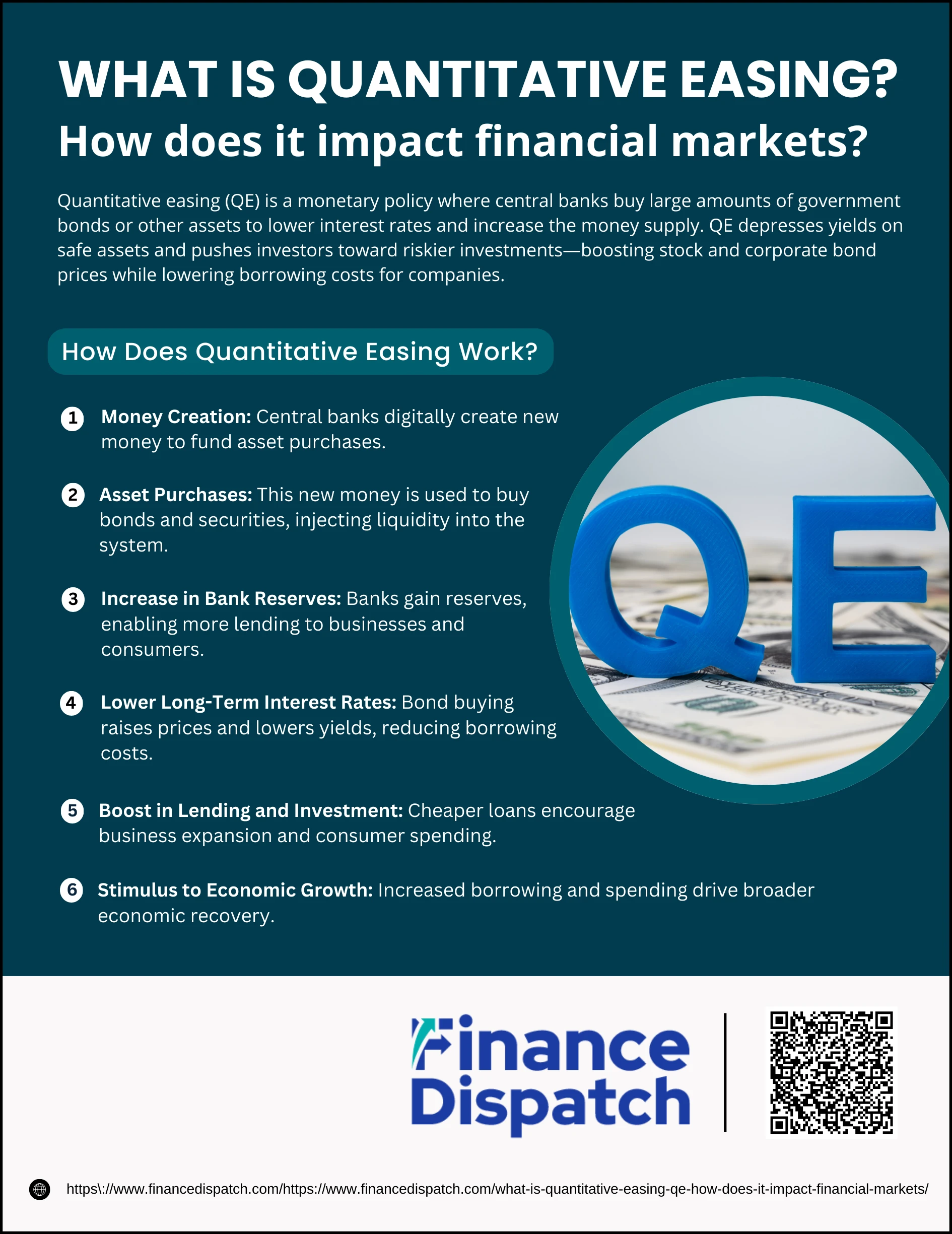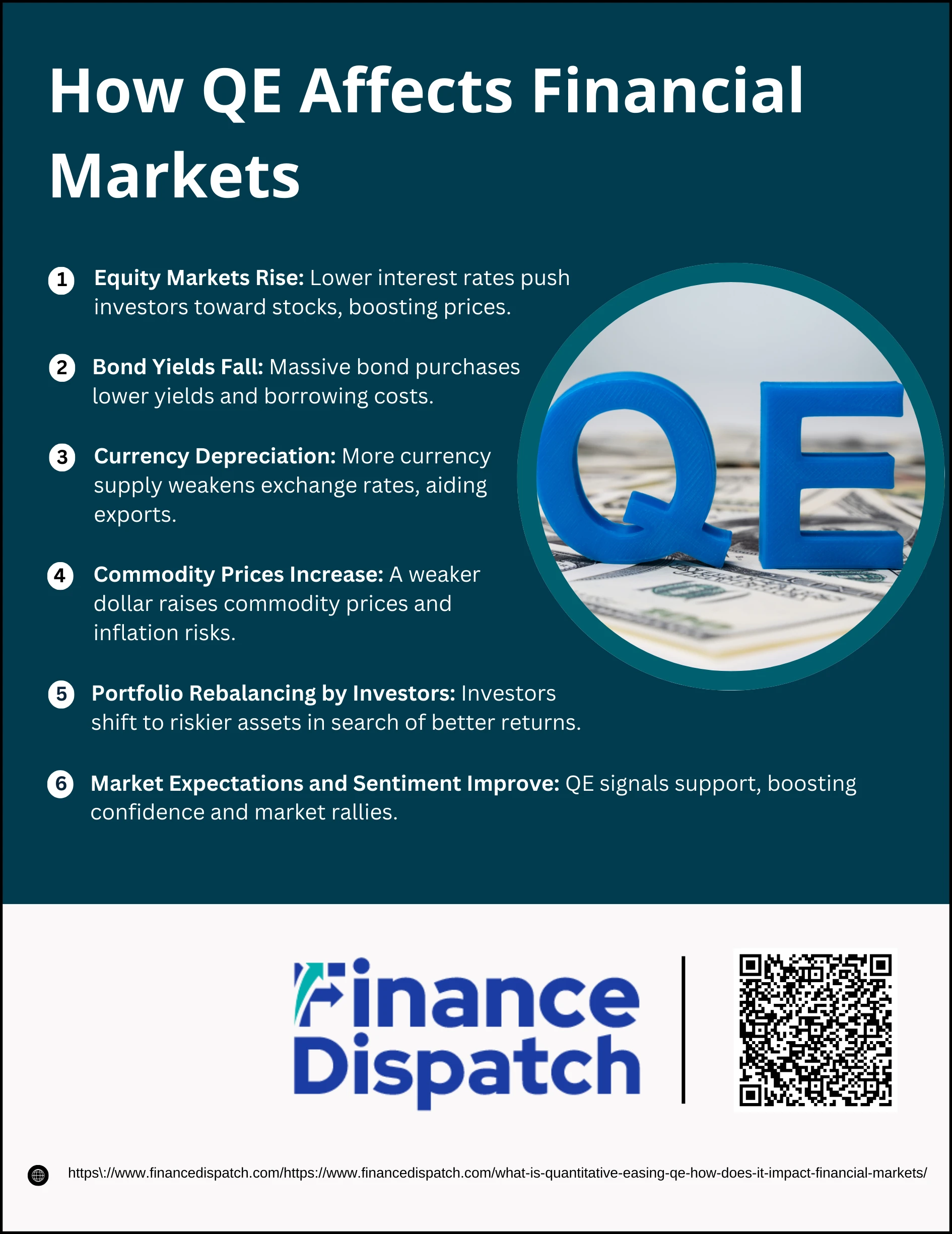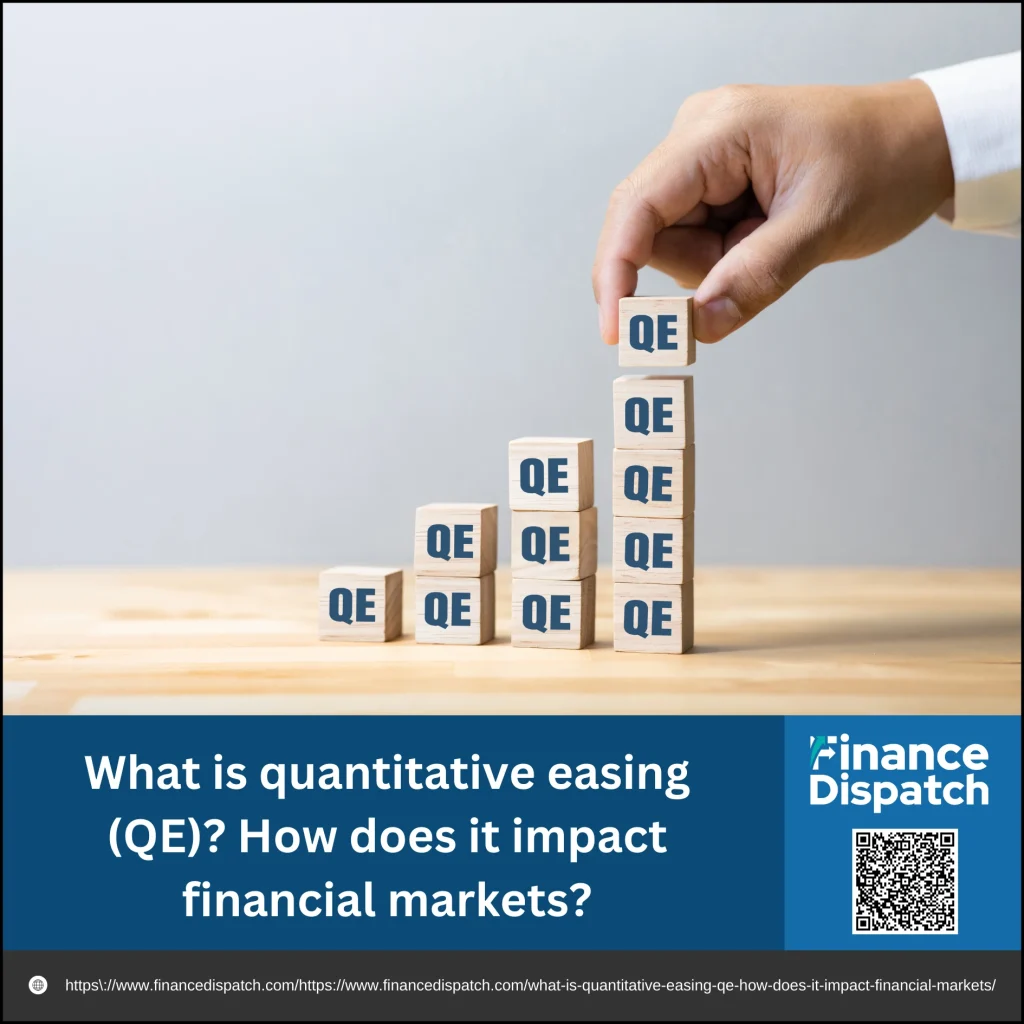In times of economic turmoil or stagnation, when conventional monetary tools like adjusting short-term interest rates lose their effectiveness, central banks often turn to an unconventional strategy known as quantitative easing (QE). This powerful monetary policy involves large-scale asset purchases—typically government bonds—by central banks to inject liquidity into the financial system. The goal is to lower long-term interest rates, encourage lending, and stimulate economic activity. But while QE can act as a lifeline during financial crises, its effects ripple across various sectors of the economy, especially financial markets. This article explores what quantitative easing is, how it works, and the profound ways it shapes market behavior, investment decisions, and global economic dynamics.
What is Quantitative Easing (QE)?
Quantitative Easing (QE) is a non-traditional monetary policy tool used by central banks to stimulate the economy when standard methods, like lowering short-term interest rates, are no longer effective. Under QE, a central bank creates new money to purchase financial assets—primarily government bonds and sometimes corporate securities—from the open market. This process increases the money supply, lowers long-term interest rates, and provides banks with more liquidity to lend to businesses and consumers. Unlike directly printing physical currency, QE involves digital money creation that flows through the banking system, aiming to revive borrowing, investment, and overall economic activity during periods of financial stress or recession.
 How Does Quantitative Easing Work?
How Does Quantitative Easing Work?
Quantitative Easing (QE) is a process used by central banks to stimulate the economy when traditional tools like interest rate cuts are no longer effective—typically when rates are near zero. QE aims to lower long-term interest rates and increase liquidity in the financial system. This is achieved by creating new money and using it to purchase financial assets, which indirectly encourages borrowing, investing, and spending.
1. Money Creation
The first step in QE is the creation of new money by the central bank. Unlike physical currency printing, this money is created digitally. The central bank does this by crediting its own account, essentially expanding its balance sheet. This newly created electronic money is the foundation of QE and will be used to buy assets in the financial markets.
2. Asset Purchases
The central bank uses the newly created money to purchase financial assets—primarily long-term government bonds, but sometimes corporate bonds or mortgage-backed securities as well. These purchases are made from commercial banks, insurance companies, pension funds, and other financial institutions. By doing so, the central bank injects liquidity directly into the financial system.
3. Increase in Bank Reserves
When commercial banks sell bonds to the central bank, they receive payment in the form of bank reserves. These reserves are deposited into their accounts at the central bank, increasing their ability to lend. This influx of cash means banks now have more money than before, which ideally enables them to extend more credit to businesses and consumers.
4. Lower Long-Term Interest Rates
By purchasing a large volume of bonds, the central bank increases their demand. This pushes up bond prices and lowers their yields (interest rates). Since bond yields influence other types of long-term interest rates—like mortgages, auto loans, and business loans—this helps to reduce borrowing costs throughout the economy.
5. Boost in Lending and Investment
With cheaper borrowing costs, businesses are more likely to take loans to expand operations, invest in new projects, or hire workers. Consumers are also more inclined to take out mortgages or personal loans to make purchases. This increase in credit activity leads to higher levels of spending and investment across the economy.
6. Stimulus to Economic Growth
All these effects combined—higher liquidity, lower interest rates, and increased borrowing—stimulate broader economic activity. As companies invest and hire, and consumers spend more, demand increases, which can help lift an economy out of a recession or prevent it from slipping further into decline. This is the ultimate objective of QE: to jumpstart economic growth during periods of financial distress.
When and Why is QE Used?
Quantitative Easing (QE) is typically reserved for extraordinary economic conditions—when traditional monetary policies, like adjusting short-term interest rates, are no longer sufficient to support economic growth. Central banks turn to QE as a last resort to inject liquidity, stabilize financial markets, and encourage lending when the economy faces severe downturns or systemic risk.
Here are the key situations when and why QE is used:
1. Interest Rates Are Near Zero
When short-term interest rates are already close to zero, central banks cannot lower them further to stimulate borrowing. QE provides an alternative way to ease financial conditions without altering interest rates.
2. Economic Recession or Stagnation
During prolonged economic slowdowns or recessions, QE is used to boost credit availability, encourage spending, and support job creation.
3. Financial Market Dysfunction
In times of crisis—such as the 2008 financial meltdown or the COVID-19 pandemic—financial markets can freeze. QE restores market confidence by ensuring liquidity and smoothing financial operations.
4. Deflationary Pressures
QE is employed to counter deflation, a harmful drop in prices that can lead to reduced consumer spending and investment, by encouraging inflation toward targeted levels.
5. Preventing a Credit Crunch
QE helps avoid situations where banks hoard cash and reduce lending. By increasing reserves, it aims to promote credit flow to businesses and consumers.
6. Supporting Government Fiscal Measures
QE can complement fiscal policies by providing the financial environment needed for government spending programs to take effect more efficiently.
7. Encouraging Portfolio Rebalancing
By buying safe assets like government bonds, QE nudges investors toward riskier assets such as corporate bonds or equities, stimulating capital markets and business growth.
 How QE Affects Financial Markets
How QE Affects Financial Markets
Quantitative Easing (QE) has far-reaching implications for financial markets. By injecting massive amounts of liquidity into the economy through asset purchases, central banks not only aim to stimulate lending and investment but also influence the pricing and behavior of financial assets. These changes ripple through the stock market, bond market, currency exchange rates, and even commodities. While QE is designed to support economic recovery, its effects on markets can be both beneficial and destabilizing, depending on how investors respond.
Here’s a closer look at how QE shapes financial markets:
1. Equity Markets Rise
When central banks implement QE, long-term interest rates fall, making stocks more attractive compared to bonds and savings accounts. As a result, investors seek higher returns by reallocating funds into equities. The surge in demand pushes up stock prices, especially in sectors like technology and finance. This often leads to bull markets during QE periods, as was seen in the years following the 2008 financial crisis and the 2020 pandemic.
2. Bond Yields Fall
QE involves central banks purchasing large quantities of government or corporate bonds. These purchases drive bond prices up and push yields down. Falling yields reduce borrowing costs across the economy, making it cheaper for corporations and governments to finance projects or refinance debt. However, persistently low yields may also discourage long-term savings.
3. Currency Depreciation
Increasing the supply of a nation’s currency typically weakens its value against other currencies. A weaker currency makes exports more competitive, which can boost a country’s trade balance. But at the same time, it makes imports more expensive, potentially leading to higher consumer prices and inflation. This is particularly impactful in countries heavily reliant on imported goods.
4. Commodity Prices Increase
Commodities like oil, gold, and metals are usually priced in U.S. dollars. When QE causes the dollar to depreciate, these commodities become more expensive in dollar terms. Investors may also flock to commodities as a hedge against inflation, further driving prices up. This can benefit commodity-exporting nations but may increase costs for consumers globally.
5. Portfolio Rebalancing by Investors
QE lowers returns on safe-haven assets like Treasury bonds. In search of yield, institutional and retail investors shift their capital into higher-risk investments such as corporate bonds, real estate, emerging markets, or equities. This “chasing of returns” is a key mechanism through which QE stimulates broader financial markets, though it can also lead to inflated asset valuations and financial bubbles.
6. Market Expectations and Sentiment Improve
QE acts as a powerful psychological signal. When a central bank announces asset purchases, it reassures investors that monetary authorities are committed to stabilizing the economy. This boosts market confidence and often triggers rallies in equities and bonds—even before the purchases begin. However, when QE programs end or taper off, markets may react with volatility due to fears of reduced support, a phenomenon known as the “taper tantrum.”
Real-World Examples of QE
Quantitative Easing has been implemented by numerous central banks across the world in response to economic crises, most notably during the 2008 global financial meltdown and the COVID-19 pandemic. While the core strategy—buying large-scale financial assets to inject liquidity—is consistent, the scope, duration, and effectiveness of QE programs have varied significantly across countries. The following table highlights some of the most notable QE implementations by major central banks.
| Country / Region | Time Period | QE Actions | Outcomes / Notes |
| United States (Fed) | 2008–2014; 2020–2021 | Purchased over $4 trillion in Treasuries and MBS across QE1, QE2, QE3, and QE4 | Lowered interest rates, boosted stock markets, increased excess bank reserves |
| Japan (BoJ) | 2001–2006; 2013–2020 | Bought government bonds, ETFs, and corporate debt; introduced Yield Curve Control | Temporarily increased GDP and exports; long-term growth remained stagnant |
| European Union (ECB) | 2015–2018; 2020–2022 | Monthly bond purchases under APP and PEPP totaling over €2 trillion | Helped reduce bond yields and stabilized the Eurozone economy during crises |
| United Kingdom (BoE) | 2009–2020 | Asset purchases totaling £895 billion, including gilts and corporate bonds | Aimed to counter effects of Brexit and COVID-19; unclear long-term growth impact |
| Switzerland (SNB) | 2008–2015 | Purchased assets exceeding annual national output | Reduced deflation risks; long-term effect on economic recovery still debated |
| China (PBoC) | 2020 (suspected) | Large bond purchases, though not officially declared as QE | Increased liquidity during COVID-19, but no formal QE framework announced |
Benefits of Quantitative Easing
Quantitative Easing (QE) offers several advantages, especially during times of economic crisis or stagnation. When traditional monetary tools like lowering interest rates are no longer effective, QE serves as a powerful alternative to stimulate economic activity. By increasing liquidity, lowering borrowing costs, and restoring market confidence, QE can help prevent deeper recessions and support a faster recovery.
Here are some of the key benefits of QE:
1. Stimulates Economic Growth
By lowering long-term interest rates and encouraging lending, QE boosts spending by both consumers and businesses, leading to increased economic output.
2. Reduces Borrowing Costs
QE pushes down interest rates, making it cheaper for households to take out loans and for companies to finance investments and expansion plans.
3. Supports Financial Markets
Injecting liquidity into the market can help stabilize volatile financial systems, reduce panic selling, and boost asset prices.
4. Prevents Deflation
By increasing the money supply and encouraging spending, QE helps counteract deflationary pressures, which can paralyze an economy.
5. Encourages Investment
Lower yields on bonds and savings accounts push investors toward higher-risk assets like stocks, driving capital into businesses and fueling growth.
6. Boosts Employment
As businesses expand due to cheaper credit and higher demand, they are more likely to hire, reducing unemployment rates.
7. Weakens the Currency to Aid Exports
A lower-valued currency resulting from QE makes a country’s exports cheaper and more competitive internationally, which can help improve the trade balance.
Risks and Drawbacks of QE
While Quantitative Easing (QE) can be an effective tool for stimulating the economy, it is not without significant risks. The long-term implications of creating vast amounts of money and artificially suppressing interest rates can lead to unintended economic and financial consequences. Critics argue that QE may distort market signals, increase inequality, and create conditions ripe for future instability if not carefully managed.
Here are the major risks and drawbacks associated with QE:
1. Inflation or Hyperinflation
Injecting excessive liquidity into the economy can drive up prices if the money supply grows faster than economic output, potentially leading to runaway inflation.
2. Asset Bubbles
Low interest rates and excess liquidity may inflate the value of assets like stocks and real estate beyond their fundamental worth, increasing the risk of market crashes.
3. Income and Wealth Inequality
Rising asset prices tend to benefit wealthier individuals who own stocks and property, while low interest rates hurt savers, exacerbating the wealth gap.
4. Currency Devaluation
A weaker domestic currency may make imports more expensive, leading to higher consumer prices and increasing the cost of living.
5. Moral Hazard
Market participants may take excessive risks, assuming that central banks will always intervene during downturns—creating unhealthy reliance on monetary support.
6. Limited Lending Impact
Even if banks have more liquidity, they may choose to hold onto excess reserves instead of increasing lending, reducing QE’s effectiveness.
7. Distorted Financial Markets
Persistent QE can lead to mispricing of risk and undermine natural market forces, making it harder to assess the true health of an economy.
8. Challenges in Exiting QE
Reversing QE, or “tapering,” can lead to market volatility, as seen during the 2013 “taper tantrum,” when bond yields surged on news of the Fed winding down its asset purchases.
Does QE Really Work?
Quantitative Easing (QE) is widely used by central banks during financial crises and economic slowdowns, but its effectiveness remains a subject of debate among economists and policymakers. While QE has proven useful in stabilizing financial markets and lowering interest rates, its broader impact on economic growth, lending activity, and long-term stability is less certain. Some view it as a necessary tool in extraordinary times, while others argue it creates more problems than it solves.
Here are the main arguments both for and against the effectiveness of QE:
Arguments in Favor of QE:
1. Stabilizes Financial Markets
QE can calm market panic during crises by providing liquidity and boosting investor confidence.
2. Lowers Long-Term Interest Rates
By increasing demand for government bonds, QE pushes down yields, making borrowing cheaper for consumers and businesses.
3. Encourages Lending and Investment
With more liquidity in the system and lower borrowing costs, banks are encouraged to lend, and companies are more likely to invest.
4. Supports Asset Prices
Rising stock and bond prices help restore household and corporate wealth, improving confidence and spending.
5. Prevents Deflation
QE can help avoid a deflationary spiral by increasing the money supply and stimulating demand.
Arguments Against QE:
1. Uncertain Impact on Economic Growth
While QE lowers rates, it does not guarantee that banks will lend or that consumers will spend, limiting its real-world effect.
2. Widening Inequality
QE tends to benefit those who already own financial assets, disproportionately helping the wealthy and leaving others behind.
3. Encourages Risk-Taking and Bubbles
Investors may chase riskier assets in search of yield, leading to inflated prices and potential future crashes.
4. Diminishing Returns Over Time
Repeated use of QE may become less effective, requiring larger programs to achieve the same results.
5. Complicates Policy Reversal
Unwinding QE can be difficult without disrupting markets, especially if economies have become reliant on cheap money.
QE vs. Quantitative Tightening (QT)
Quantitative Easing (QE) and Quantitative Tightening (QT) are opposite monetary policy tools used by central banks to influence economic activity. While QE involves injecting liquidity into the financial system by purchasing assets, QT withdraws liquidity by reducing central bank holdings, either by selling assets or allowing them to mature without reinvestment. Both strategies aim to manage inflation, interest rates, and economic growth but have contrasting effects on markets and borrowing conditions.
The table below compares key aspects of QE and QT:
| Aspect | Quantitative Easing (QE) | Quantitative Tightening (QT) |
| Purpose | Stimulate economic growth and increase liquidity | Curb inflation and reduce excess liquidity |
| Central Bank Action | Buys government or financial assets | Sells assets or allows them to mature without reinvestment |
| Impact on Interest Rates | Decreases long-term interest rates | Increases long-term interest rates |
| Money Supply | Expands the money supply | Contracts the money supply |
| Effect on Markets | Boosts asset prices and investor confidence | May depress asset prices and increase volatility |
| Impact on Currency | Often weakens the currency, aiding exports | May strengthen the currency, making imports cheaper |
| Timing of Use | During recessions, crises, or periods of low inflation | During periods of economic overheating or high inflation |
| Investor Behavior | Encourages risk-taking and investment in equities | Promotes caution and reallocation to safer assets |
Conclusion
Quantitative Easing (QE) is a powerful and unconventional monetary policy tool used by central banks to stabilize economies during periods of crisis or stagnation. By increasing liquidity, lowering long-term interest rates, and encouraging lending and investment, QE has played a pivotal role in preventing deeper recessions and restoring market confidence. However, it is not without risks. From inflation and asset bubbles to widening inequality and market distortions, the long-term consequences of QE remain a subject of debate. As global economies continue to evolve, understanding both the benefits and drawbacks of QE—and how it contrasts with policies like Quantitative Tightening (QT)—is essential for policymakers, investors, and the public alike.



